Engineers: You Can Disrupt Climate Change
Decarbonization, carbon capture, and solar-radiation management will provide work for decades to come
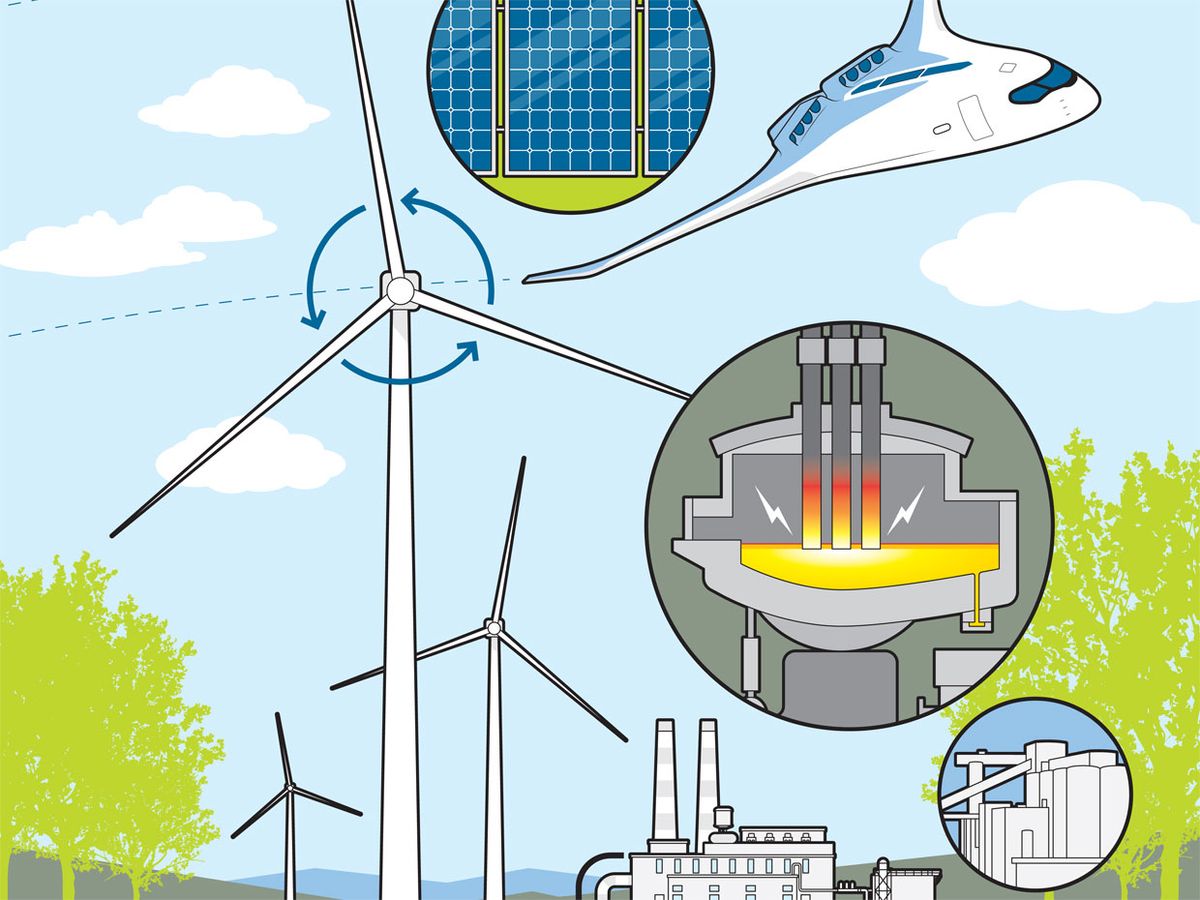
Seven years ago, we published an article in IEEE Spectrumtitled “What It Would Really Take to Reverse Climate Change.“ We described what we had learned as Google engineers who worked on a well-intentioned but ultimately failed effort to cut the cost of renewable energy. We argued that incremental improvements to existing energy technologies weren’t enough to reverse climate change, and we advocated for a portfolio of conventional, cutting-edge, and might-seem-crazy R&D to find truly disruptive solutions. We wrote: “While humanity is currently on a trajectory to severe climate change, this disaster can be averted if researchers aim for goals that seem nearly impossible. We’re hopeful, because sometimes engineers and scientists do achieve the impossible.”
Today, still at Google, we remain hopeful. And we’re happy to say that we got a few things wrong. In particular, renewable energy systems have come down in price faster than we expected, and adoption has surged beyond the predictions we cited in 2014.
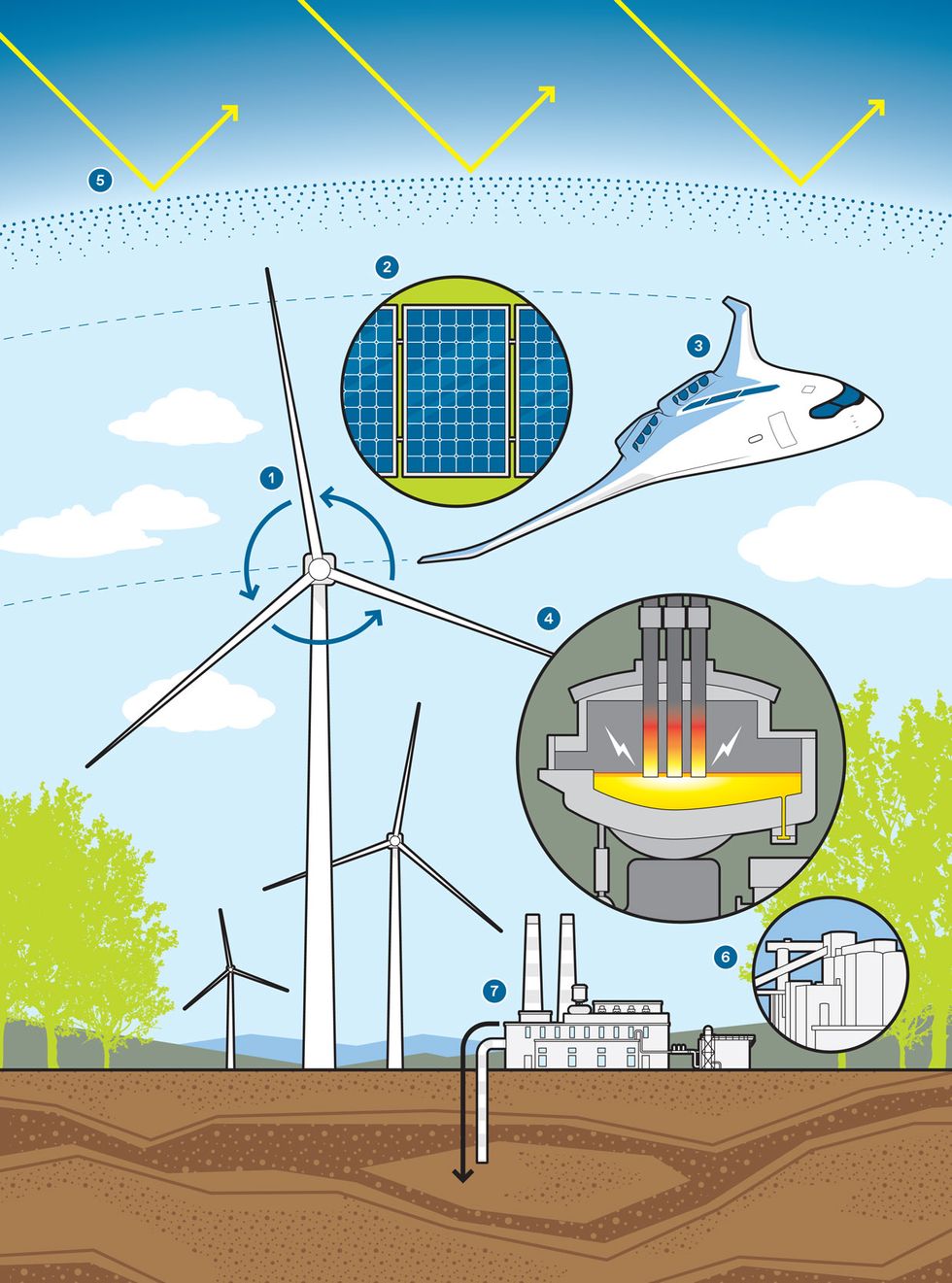
Our earlier article referred to “breakthrough” price targets ( modeled in collaboration with the consulting firm McKinsey & Co.) that could lead to a 55 percent reduction in U.S. emissions by 2050. Since then, wind and solar power prices have met the targets set for 2020, while battery prices did even better, plummeting to the range predicted for 2050. These better-than-expected price trends, combined with cheap natural gas, caused U.S. coal usage to drop by half. The result: By 2019, U.S. emissions had fallen to the level that the McKinsey scenario forecast for 2030—a decade sooner than our model predicted.
And thanks to this progress in decarbonizing electricity production, engineers are seeking and finding numerous opportunities to switch existing systems based on the combustion of fossil fuels to lower-carbon electricity. For example, electric heat pumps are becoming a cost-effective replacement for heating fuel, and electric cars are coming down in price and going up in range.
Even with all this progress, though, we’re still on a trajectory to severe climate change: a 3 °C rise by 2100. Many countries are not meeting the emissions reductions they pledged in the 2015 Paris Agreement. Even if every country were to meet its pledge, it would not be enough to limit planetwide warming to 1.5 °C, which most experts consider necessary to avoid environmental disaster. Meeting pledges today would require a drastic slashing of emissions. If these wholesale emission reductions don’t happen, as we think likely, then other strategies will be needed to keep temperatures within bounds.
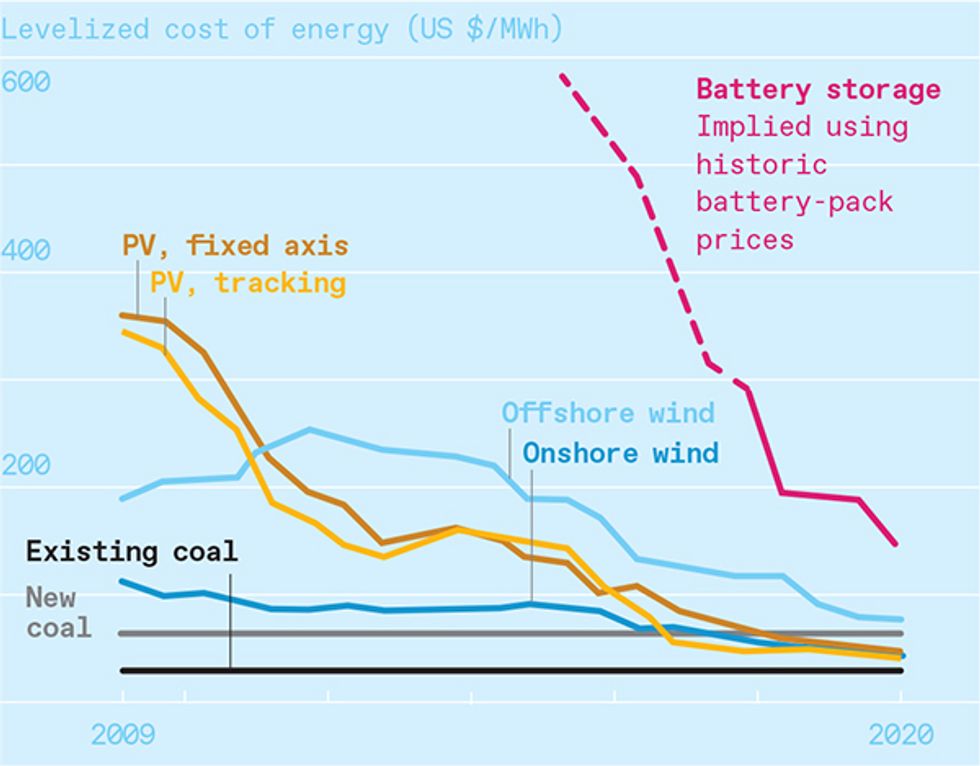
Here are some key numbers: To reverse climate change, even partially, we’ll need to bring atmospheric carbon dioxide levels down to a safer threshold of 350 parts per million; on Earth Day 2021 the figure stood at 417 ppm. We estimate that meeting that target will require removing on the order of 2,000 gigatonnes of CO2 from the atmosphere over the next century. That wholesale removal is necessary both to draw down existing atmospheric CO2 as well as the CO2 that will be emitted while we transition to a carbon-negative society (one that removes more carbon from the atmosphere than it emits).
Our opening battles in the war on climate change need engineers to work on the many existing technologies that can massively scale up. As already illustrated with wind, solar, and batteries, such scale-ups often bring dramatic drops in costs. Other industrial sectors require technological revolutions to reduce emissions. If you experiment with your own mix of climate-mitigation techniques using the En-ROADS interactive climate tool, you’ll see how many options you have to max out to change our current trajectory and achieve 350 ppm CO2 levels and a global temperature rise of no more than 1.5 °C.
So what’s an engineer who wants to save the planet to do? Even as we work on the changeover to a society powered by carbon-free energy, we must get serious about carbon sequestration, which is the stashing of CO 2 in forests, soil, geological formations, and other places where it will stay put. And as a stopgap measure during this difficult transition period, we will also need to consider techniques for solar-radiation management—deflecting some incoming sunlight to reduce heating of the atmosphere. These strategic areas require real innovation over the coming years. To win the war on climate change we need new technologies too.
Extra: The Authors Show Their Math
See “Disrupting Climate Change Is a Math Problem“ at the bottom of this article. ↓
We’re optimistic that the needed technology will emerge within a couple of decades. After all, engineers of the past took mere decades to design engines of war, build ships that could circle the globe, create ubiquitous real-time communication, speed up computation over a trillionfold, and launch people into space and to the moon. The 1990s, 2000s, and 2010s were the decades when wind power, solar power, and grid-scale batteries respectively started to become mainstream. As for which technologies will define the coming decades and enable people to live sustainably and prosperously on a climate-stable planet, well, in part, that’s up to you. There’s plenty to keep engineers hard at work. Are you ready?
Before we get to the technology challenges that need your attention, allow us to talk for a moment about policy. Climate policy is essential to the engineering work of decarbonization, as it can make the costs of new energy technologies plummet and shift markets to low-carbon alternatives. For example, by 2005, Germany was offering extremely generous long-term contracts to solar-energy producers (at about five times the average price of electricity in the United States). This guaranteed demand jump-started the global market for solar photovoltaic (PV) panels, which has since grown exponentially. In short, Germany’s temporary subsidies helped create a sustainable global market for solar panels. People often underestimate how much human ingenuity can be unleashed when it’s propelled by market forces.
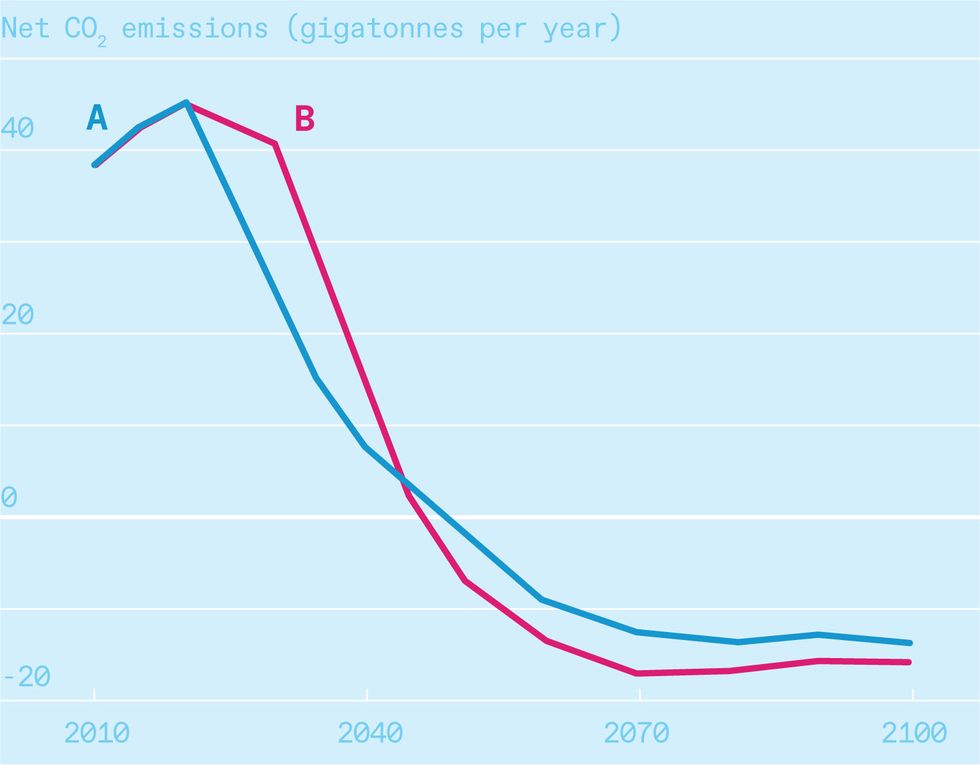
This surge in solar PV could have happened a decade earlier. Every basic process was ready by 1995: Engineers had mastered the technical steps of making silicon wafers, diffusing diode junctions, applying metal grids to the solar-cell surfaces, passivating the semiconductor surface to add an antireflective coating, and laminating modules. The only missing piece was supportive policy. We can’t afford any more of these “lost decades.” We want engineers to look at energy systems and ask themselves: Which technologies have everything they need to scale up and drive costs down—except the policy and market?
Economics Nobel laureate William Nordhaus argues that carbon pricing is instrumental to tackling climate change in his book The Climate Casino (Yale University Press, 2015). Today, carbon pricing applies to about 22 percent of global carbon emissions. The European Union’s large carbon market, which currently prices carbon at above €50 per ton (US $61), is a major reason why its airlines, steel manufacturers, and other industries are currently developing long-term decarbonization plans. But economist Mark Jaccard has pointed out that while carbon taxes are economically most efficient, they often face outsize political opposition. Climate-policy pioneers in Canada, California, and elsewhere have therefore resorted to flexible (albeit more complicated) regulations that provide a variety of options for industries to meet decarbonization objectives.
Engineers may appreciate the simplicity and elegance of carbon pricing, but the simplest approach is not always the one that enables progress. While we engineers aren’t in the business of making policy, it behooves us to stay informed and to support policies that will help our industries flourish.
Tough decarbonization challengesabound for ambitious engineers. There are far too many to enumerate in this article, so we’ll pick a few favorites and refer the reader to Project Drawdown, an organization that assesses the impact of climate efforts, for a more complete list.
Let’s consider air travel. It accounts for 2.5 percent of global carbon emissions, and decarbonizing it is a worthy goal. But you can’t simply capture airplane exhaust and pipe it underground, nor are engineers likely to develop a battery with the energy density of jet fuel anytime soon. So there are two options: Either pull CO2 directly from the air in amounts that offset airplane emissions and then stash it somewhere, or switch to planes that run on zero-carbon fuels, such as biofuels.
One interesting possibility is to use hydrogen for aviation fuel. Airbus is currently working on designs for a hydrogen-powered plane that it says will be in commercial service in 2035. Most of today’s hydrogen is decidedly bad for the climate, as it’s made from fossil methane gas in a process that emits CO2. But clean hydrogen production is a hot research topic, and the 200-year-old technique of water electrolysis—in which H2O is split into oxygen and hydrogen gas—is getting a new look. If low-carbon electricity is used to power electrolysis, the clean hydrogen produced could be used to manufacture chemicals, materials, and synthetic fuels.
Policy, particularly in Europe, Japan, and Australia, is driving hydrogen research forward. For example, the European Union published an ambitious strategy for 80 gigawatts of capacity in Europe and neighboring countries by 2030. Engineers can help drive down prices; the first goal is to reach $2 per kilogram (down from about $3 to $6.50 per kilogram now), at which point clean hydrogen would be cheaper than a combination of natural gas with carbon capture and sequestration.
Climate-friendly hydrogen could also lead to another great accomplishment: decarbonizing the production of metals. The Stone Age gave way to the Iron Age only when people figured out how to deploy energy to remove the oxygen from the metal ores found in nature. Europe was deforested in part to provide charcoal to burn in the crucibles where metalsmiths heated iron ore, so it was considered an environmental win when they switched from charcoal to coal in the 18th century. Today, thanks to the European Union’s carbon market, engineers are piloting exciting new methods to remove oxygen from metal ore using hydrogen and electric arc furnaces.
There’s still much work to do in decarbonizing the generation of electricity and production of clean fuels. Worldwide, humans use roughly one zettajoule per year—that’s 1021 joules every year. Satisfying that demand without further contributing to climate change means we’ll have to drastically speed up deployment of zero-carbon energy sources. Providing 1 ZJ per year with only solar PV, for example, would require covering roughly 1.6 percent of the world’s land area with panels. Doing it with nuclear energy alone would necessitate building three 1-gigawatt plants every day between now and 2050. It’s clear that we need a host of cost-effective and environmentally friendly options, particularly in light of large regional variations in resources.
While we consider those options, we’ll also need to make sure those sources of energy are steady and reliable. Critical infrastructure such as hospitals, data centers, airports, trains, and sewage plants need around-the-clock electricity. (Google, for one, is aggressively pursuing 24/7 carbon-free energy for its data centers by 2030.) Most large industrial processes, such as the production of glass, fertilizer, hydrogen, synthesized fuels, and cement, are currently cost-effective only when plants are operated nearly continuously, and often need high-temperature process heat.
To provide that steady carbon-free electricity and process heat, we should consider new forms of nuclear power. In the United States and Canada, new policies support advanced nuclear-energy development and licensing. Dozens of advanced nuclear-fission companies offer engineers a variety of interesting challenges, such as creating fault-tolerant fuels that become less reactive as they heat up. Other opportunities can be found in designing reactors that recycle spent fuel to reduce waste and mining needs, or that destroy long-lived waste components via new transmutation technologies.
Engineers who are drawn to really tough quests should consider nuclear fusion, where the challenges include controlling the plasma within which the fusion occurs and achieving net electric power output. This decade’s competition in advanced nuclear-energy technologies may produce winners that get investors excited, and a new round of policies could push these technologies down the cost curve, avoiding a lost decade for advanced nuclear energy.
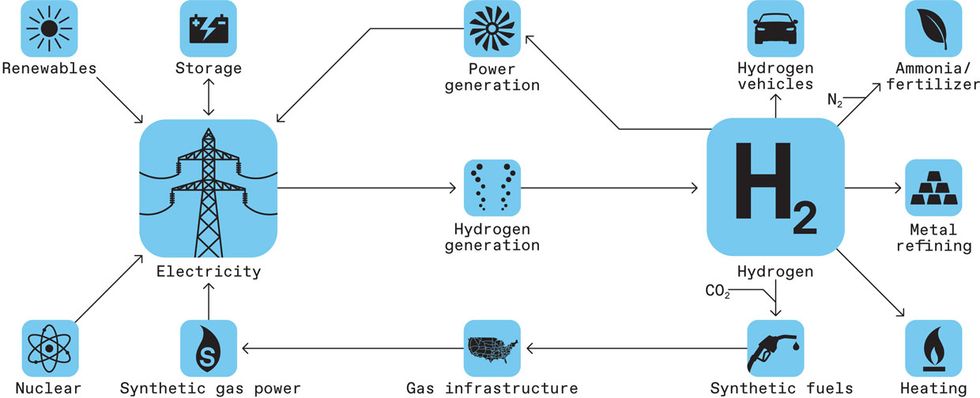
Global-scale climatepreservation is an idea that engineers should love, because it opens up new fields and career opportunities. Earth’s climate has run open loop for over 4 billion years; we are lucky that our planet’s wildly fluctuating climate was unusually stable over the 10,000 years that modern civilization arose and flourished. We believe that humankind will soon start wrapping a control loop around earth’s climate, designing and introducing controlled changes that preserve the climate.
The basic rationale for climate preservation is to avoid irreversible climate changes. The melting of the Greenland ice sheet could raise sea levels by 6 meters, or the runaway thawing of permafrost could release enough greenhouse gas to add an additional degree of global warming. Scientists agree that continuation of unchecked emissions will trigger such tipping points, although there’s uncertainty about when that would happen. The economist Nordhaus, applying the conservative precautionary principle to climate change, argues that this uncertainty justifies earlier and larger climate measures than if tipping-point thresholds were precisely known.
We believe in aggressively pursuing carbon dioxide removal because the alternative is both too grim and too expensive. Some approaches to carbon dioxide removal and sequestration are technically feasible and are now being tried. Others, such as ocean fertilization of algae and plankton, caused controversy when attempted in early experiments, but we need to learn more about these as well.
The Intergovernmental Panel on Climate Change‘s recommendation for capping warming at 1.5 °C requires cutting net global emissions almost in half by 2030, and to zero by 2050, but nations are not making the necessary emission cuts. (By net emissions, we mean actual CO2 emissions minus the CO2 that we pull out of the air and sequester.) The IPCC estimates that achieving the 1.5 °C peak temperature goal and, over time, drawing CO2 concentrations down to 350 ppm actually requires negative emissions of more than 10 Gt of CO2 per year within several decades—and this may need to continue as long as there remain atmospheric litterbugs who continue to emit CO2.
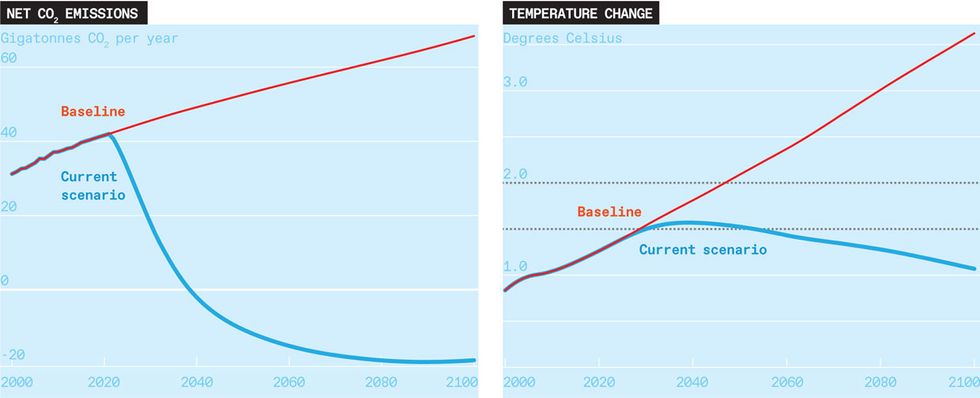
The En-ROADS tool, which can be used to model the impact of climate-mitigation strategies, shows that limiting warming to 1.5 °C requires maxing out all options for carbon sequestration—including biological means, such as reforestation, and nascent technological methods that aren’t yet cost effective.
We need to sequester CO 2, in part, to compensate for activities that can’t be decarbonized. Cement, for example, has the largest carbon footprint of any man-made material, creating about 8 percent of global emissions. Cement is manufactured by heating limestone (mostly calcite, or CaCO3), to produce lime (CaO). Making 1 tonne of cement lime releases about 1 tonne of CO2. If all the CO2 emissions from cement manufacturing were captured and pumped underground at a cost of $80 per tonne, we estimate that a 50-pound bag (about 23 kg) of concrete mix, one component of which is cement, will cost about 42 cents more. Such a price change would not stop people from using concrete nor significantly add to building costs. What’s more, the gas coming out of smokestacks at cement plants is rich in CO2 compared with the diluted amount in the atmosphere, which means it’s easier to capture and store.
About the Authors
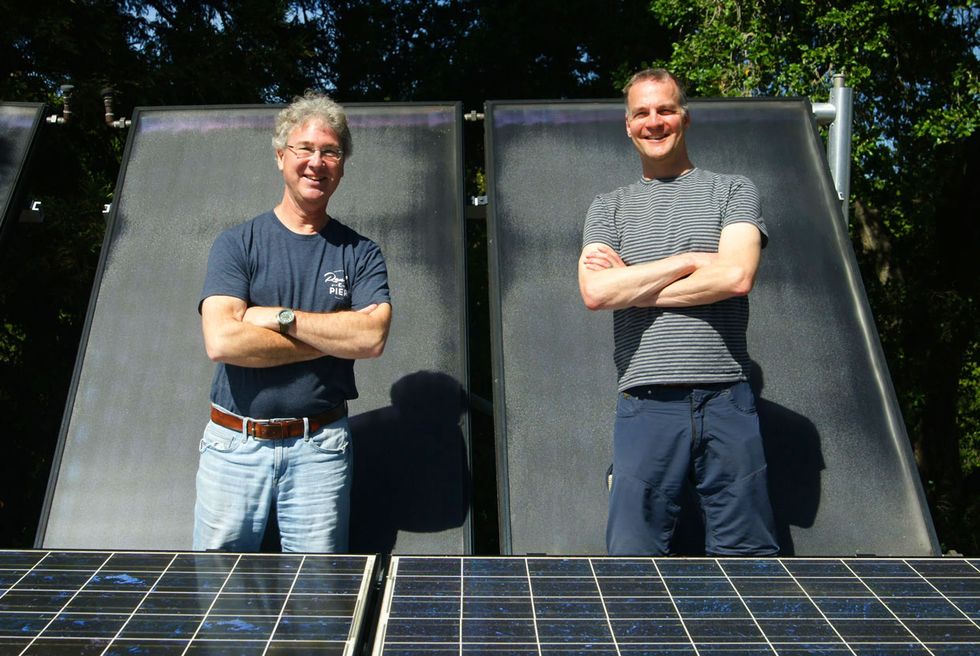
In 2014, two distinguished Google engineers wrote for IEEE Spectrum about the sobering lessons they’d learned while trying to develop renewable-energy systems that were as cheap as coal. That article, titled “What It Would Really Take to Reverse Climate Change,” struck a chord. By the metric of online readership, it was the seventh most popular article Spectrum published in the 2010s. The piece bluntly described the enormous scale of the challenge.
Seven years later, the authors, David Fork [on right in photo] and Ross Koningstein, are back with a new message, and it’s surprisingly hopeful. “It’s stunning how rapidly things have been moving since the first article was published,” says Fork. The scope of the challenge is still enormous, of course, but experts now have a better understanding of how a variety of technologies could be combined to prevent catastrophic climate change, the coauthors say. Many renewable-energy systems, for example, are already mature and just need to be scaled up. Some innovations need significant development, including new processes to produce steel and concrete, and geoengineering techniques to sequester carbon and temporarily reduce solar radiation. The one commonality among all these promising technologies, they conclude, is that engineers can make a difference on a planetary scale.
“We need engineers to recognize where these opportunities are, and then not step on the gas pedal but step on the accelerator of an electric vehicle,” says Koningstein. Concerned about the pessimistic tone of most climate coverage, the authors argue that wise policies, market pressure, and human creativity can get the job done. “When you put the right incentives in place, you capture the ingenuity of the masses,” says Fork. “All of us are smarter than any of us.”
Capturing cement’s emissions will be good practice as we get ready for the bigger lift of removing 2,000 Gt of CO 2 directly from the atmosphere over the next 100 years. Therein lies one of the century’s biggest challenges for scientists and engineers. A recent Physics Today article estimated the costs of directly capturing atmospheric CO2 at between $100 and $600 per tonne. The process is expensive because it requires a lot of energy: Direct air capture involves forcing enormous volumes of air over sorbents, which are then heated to release concentrated CO2 for storage or use.
We need a price breakthrough in carbon capture and sequestration that rivals what we have seen in wind power, solar energy, and batteries. We estimate that at $100 per tonne, removing those 2,000 Gt of CO 2 would account for roughly 2.8 percent of global GDP for 80 years. Compare that cost with the toll of hitting a climate tipping point, which no amount of spending could undo.
In principle, there are enough subterranean rock formations to store not just gigatonnes but teratonnes of CO2. But the scale of the sequestration required, and the urgency of the need for it, calls for outside-the-box thinking. For example, massive-scale, low-cost carbon removal may be possible by giving nature an assist. During the planet’s Carboniferous period, 350 million years ago, nature sequestered so much carbon that it reduced atmospheric CO2 from over 1,000 ppm to our preindustrial level of 260 ppm (and created coal in the process). The mechanism: Plants evolved the fibrous carbon-containing material lignin for their stems and bark, millions of years before other creatures evolved ways to digest it.
Now consider that the ocean absorbs and almost completely reemits about 200 Gt of CO 2 per year. If we could prevent 10 percent of this reemission for 100 years, we would meet the goal of sequestering 2,000 Gt of CO2. Perhaps some critter in the ocean’s food chain could be altered to excrete an organic biopolymer like lignin that’s hard to metabolize, which would settle to the seafloor and sequester carbon. Phytoplankton reproduce quickly, offering a quick path to enormous scale. If our legacy of solving climate change is a few millimeters of indigestible carbon-rich poop at the bottom of the ocean, we’d be okay with that.
Altering radiative forcing—that is, reflecting more sunlight to space—could be used as a temporary and stopgap measure to limit warming until we’ve made a dent in reducing atmospheric CO2 levels. Such efforts could avoid the worst physical and economic impacts of temperature rise, and would be decommissioned once the crisis has passed. For example, we could reduce the formation of airplane contrails, which trap heat, and make roofs and other surfaces white to reflect more sunlight. These two measures, which could reduce our expected planetary warming by about 3 percent, would help the public better appreciate that our collective actions affect climate.
There are more ambitious proposals that would reflect more sunlight, but there is much to debate about the positive and negative consequences of such actions. We believe that the most responsible path forward is for engineers, chemists, biologists, and ecologists to test all the options, particularly those that can make a difference at a planetary scale.
We don’t claim to know which technologies will prevent a dystopian world that’s over 2° C warmer. But we fervently believe that the world’s engineers can find ways to deliver tens of terawatts of carbon-free energy, radically decarbonize industrial processes, sequester vast amounts of CO 2, and temporarily deflect the necessary amounts of solar radiation. Effective use of policies that support worthy innovations can help move these technologies into place within the next three or four decades, putting us well on our way to a stable and livable planet. So, engineers, let’s get to work. Whether you make machines or design algorithms or analyze numbers, whether you tinker with biology, chemistry, physics, computers, or electrical engineering, you have a role to play.
The views expressed here are solely those of the authors and do not represent the positions of Google or the IEEE.
Disrupting Climate Change Is a Math Problem
And we’re showing our work
We, the authors of this article, work at Google on the renewable energy team, and in our jobs we could never get away with presenting a bold idea if we didn’t have the math to back it up. So we’re presenting here some data and calculations to support the biggest claims in our article.
We need to remove about 2000 gigatonnes of CO2from the atmosphere
The Intergovernmental Panel on Climate Change (IPCC)special report “ Global Warming of 1.5° C“ states that cumulative CO2 emissions from 1876 to the end of 2010 were 1,930 gigatonnes CO2, and that by the end of 2017, the amount had reached 2,220 Gt CO2. These emissions were accompanied by an estimated 1° C surface temperature change over that time span. So to reverse the effects of climate change we need to remove at least 2,000 Gt CO2 from the atmosphere and oceans. Add to that total our emissions going forward, which are currently 40 Gt of CO2 per year. There are other ways to get to a number of the same scale. That same IPCC report also states: “Pathways that aim for limiting warming to 1.5° C by 2100 after a temporary temperature overshoot rely on large-scale deployment of carbon dioxide removal (CDR) measures.” This acknowledgment has led to including large-scale (as in tens of Gt CO2 per year) carbon removal in models for reducing net carbon emissions. It’s important to understand that net carbon emissions means actual CO2 emissions minus the CO2 that we pull out of the air and sequester. The IPCC report states a goal of reducing net emissions to zero by 2050, using both significant emissions cuts and carbon removal to limit global warming to 1.5° C. A graphic shows net emissions gradually decline to almost negative 20 Gt CO2 per year by the end of the century, and would clearly have to continue on at that scale. If about 20 Gt CO2 per year is removed for the next 100 years, that would be 2000 Gt CO2. We don’t need to know the precise amount of necessary CO2 removal to evaluate the suitability of potential approaches to this problem: Whether the number is about 2000 Gt or even higher, net negative emissions would need to continue for perhaps a century at 20 Gt CO2 per year to restore the atmosphere (and oceans) to desired levels. So when setting targets for carbon removal, think tens of gigatonnes CO2per year—think big!
Humans use about 1 zettajoule of energy per year
In 2017 global energy consumption was about 160,000 terawatt-hours. This is about 6x1020 joules. Over time energy consumption has always increased as development has improved the quality of people’s lives. It therefore seems likely that later this century, humans will be using even more than 6x1020 joules of energy. In our article, we round up humanity’s energy use to 1 zettajoule (1021 joules) for simplicity.
To supply 1 ZJ of energy per year with photovoltaic solar panels, we’d need to cover 1.6 percent of the planet’s land surface
Solar installations are rated in terms of their peak capacity, which is their power production in full sun. To determine the output of an installation, we need to know its capacity factor, which is the average utilization of its peak capacity. In a good location for solar PV, the capacity factor can be about 20 percent. For every watt of peak capacity with a 20 percent capacity factor, one year of operation will produce 6,307,200 joules of energy (365 days x 24 hours x 60 minutes x 60 seconds x 0.2 capacity). Dividing this number into 1 ZJ reveals that it would require solar panels with a peak capacity of 160 terrawatts to produce 1 ZJ per year of electricity generation. A utility scale solar farm typically has a ⅓ ratio of panel area to land area, which translates to about 66 peak megawatts of power generation per square kilometer. To produce 160 TW of peak solar generation capacity we would need about 2.4 million square kilometers, or about 1.6 percent of Earth’s land area. For comparison, farming claims about 40 percent of Earth’s land surface. About one-third of the planet’s land surface is desert; hence in a scenario where desert land is used for solar energy generation 1 ZJ of energy per year could be produced without significantly impacting the food supply.
To supply 1 ZJ of energy per year with nuclear power, we’d have to build three 1-gigawatt plants per day for 30 years
A typical nuclear power plant today generates about 1 gigawatt of power. Let’s say that the plant operates with a capacity factor of 95 percent, meaning that it’s up and running at its design capacity 95 percent of the time. This one plant will produce 3x10 16 Joules per year. One zettajoule is 1021 Joules. So it would take a little over 33,000 1-GW plants to provide the capacity for generating 1 ZJ per year. Given 30 years to build this quantity of nuclear power plants, the average rate of construction would be about 3 plants per day.
A 50-pound bag of concrete mix will cost about 42 cents more if the emissions from cement manufacturing are captured and stored
Making a tonne of cement by burning fossil fuels to provide process heat releases CO 2in two ways: It’s released during the combustion process and also comes from the heated feedstock of carbonate rock. Combined, the emissions are about 0.93 tonnes of carbon dioxide per tonne of cement. The roughly “1 tonne per tonne” rule of thumb makes it rather easy to compute the cost of producing zero-carbon cement. As of this writing, the price of cement averages around $125 per tonne. If a cement plant were to attach machinery that captured and sequestered its carbon emissions for a cost of $80 per tonne of CO2 (an optimistic cost estimate), this process would add 60 percent to the cost of cement (0.93 x $80 / $125 is about 0.6). A 50-pound bag of cement weighs 0.023 tonnes and produces emissions of about 0.021 tonnes CO2, hence at a sequestration cost of $80 per tonne, the added cost would be about $1.69. Ready-mix concrete is about 25 percent cement by weight. That cement would add about $0.42 (0.25 x $1.69) to the cost of a 50-pound bag of concrete. Cement is such a valuable material, it’s arguable that if the price were to increase significantly more than this amount, even if the price were to double, humanity would still use lots of it.
Removing 2,000 Gt of CO2 would account for roughly 2.8 percent of global GDP for 80 years
In the article, we suggest that 2.8 percent of global gross domestic product would be a reasonable amount of money to spend to pull down the levels of CO2 in the atmosphere. In 2021, global gross domestic product will be about US $90 trillion. Choosing the timeframe for drawing 2000 Gt of CO2 is a very uncertain task; 80 years seems like a reasonable number to get the planet into decent shape by early next century. This time horizon gives us an annual CO2 capture and sequestration target of about 25 Gt of CO2 per year. The cost of mechanical direct air capture of CO2 and sequestration is currently hundreds of dollars per tonne; in the article we note that the area is ripe for creative R&D. If the price could be reduced to $100 per tonne, drawing down those 25 Gt of CO2 per year works out to $2.5 trillion per year, or about 2.8 percent of current global GDP. Carbon capture is perhaps the best lever to use for stabilizing Earth’s climate in the long term—meaning a time scale of centuries. Drawing down the greenhouse gas concentrations to below current levels will eventually cool the land and ocean temperatures, and will reverse ocean acidification as well.
- Capturing Climate Change - IEEE Spectrum ›
- Can Technology Reverse Climate Change? - IEEE Spectrum ›
- What It Would Really Take to Reverse Climate Change - IEEE ... ›
- Here’s How We Could Brighten Clouds to Cool the Earth - IEEE Spectrum ›
- Making Information Tech Greener Can Help Address the Climate Crisis - IEEE Spectrum ›
- Making Information Tech Greener Can Help Address the Climate Crisis - IEEE Spectrum ›
- Climate Expert: "Don't Call It Geoengineering" ›
- Can Software Save the World at a Profit? - IEEE Spectrum ›
- Test of Planet-Cooling Scheme Could Start in 2022 ›
- How Engineers Can Help Protect Earth From Worsening Climate Change - IEEE Spectrum ›
- IEEE’s Plan To Help Combat Climate Change - IEEE Spectrum ›
- 4,000 Robots Roam the Oceans, Climate in Their Crosshairs - IEEE Spectrum ›
- AI's Benefit to Solar and Wind Power Isn't Hot Air - IEEE Spectrum ›
- Climate Change is NSF Engineering Alliance’s Top Research Priority - IEEE Spectrum ›
- NSF Engineering Alliance Supports IEEE’s Plan on Climate Change - IEEE Spectrum ›
- Chip Fabs Go Green - IEEE Spectrum ›
- Four Startups Aim to Change the Climate Tech Game - IEEE Spectrum ›
- How Roboticists Can Tackle Climate Change - IEEE Spectrum ›
- Japan’s Moonshot Program Aims Sky-High—at the Weather - IEEE Spectrum ›


